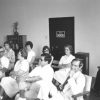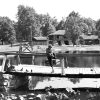calsfoundation@cals.org
Caldwell Jones (1950–2014)
Caldwell Jones was a professional basketball player who had a seventeen-season career in the American Basketball Association (ABA) and the National Basketball Association (NBA) in the 1970s and 1980s.
Caldwell Jones Jr. was born on August 4, 1950, in McGehee (Desha County) to Caldwell Jones Sr. and Cecelia Jones, who were cotton farmers. He had a sister and six brothers, three of whom would also ultimately play in the NBA—but not before they spent considerable time working on the farm. Years later, Jones recalled that the cotton farm was “the way we survived,” although all the planting and harvesting were balanced by some fun, highly competitive family pick-up games that Jones remembered fondly.
Basketball was the key to Jones leaving the farm behind. After a standout career at Desha Central High School, he began an outstanding college career at Albany State College in Georgia, where he played from 1969 to 1973. (One of the Jones brothers manned the pivot for Albany State each year from 1961 to 1979, while brother Oliver Jones served as the school’s head coach for twenty-eight years before his retirement in 2000.) Jones graduated in 1973 with a degree in business administration.
From Albany State, Jones entered the ABA, where he played for the San Diego Conquistadors under head coach Wilt Chamberlain in 1973–1974. Jones led the ABA in blocked shots and blocked shots per game in his rookie year (and he led the league in blocked shots per game again in his second), while also finishing second in the Rookie of the Year voting. He was named to the league’s All-Star team in his second year. As the ABA struggled to survive, Jones played with the San Diego Sails, the Kentucky Colonels, and the Spirits of St. Louis in 1975–1976 before the ABA officially merged with the NBA. Out of that arrangement, Jones ended up with the Philadelphia 76ers.
While Jones had been a prolific scorer in his early days in the ABA, when he joined the Philadelphia 76ers in 1976, he readily assumed the role of rebounder and defensive specialist on a team that had Julius Erving and George McGinnis as the offensive sparkplugs. The lithe six-foot-eleven-inch, 217-pound Jones willingly focused on rebounding while also distinguishing himself as a versatile defender who could not only go head-to-head against big men like Kareem Abdul Jabbar but could also shadow perpetual motion players like Celtics forward Larry Bird.
Jones played on eight teams over the course of his seventeen-season pro career, but he spent the most time with the 76ers, where he played from 1976 to 1982, and was a critical cog on teams that reached the NBA finals in 1977, 1980, and 1982, only to lose to the Portland Trailblazers in 1977 and to the Los Angeles Lakers in the latter two clashes.
Following his time with the 76ers, Jones played two seasons with the Houston Rockets, where his brother Major Jones was a teammate; played a single season with the Chicago Bulls, where elder statesman Jones played with Michael Jordan in the future NBA icon’s rookie year; and then after four years with the Portland Trailblazers, spent his final season, 1989–1990, in San Antonio, where he helped future Hall of Famer David Robinson adapt to life in the NBA.
In 1992, Jones married Vanessa Dorton, a school administrator he had met in Portland. The couple had three daughters.
Over the course of his professional career, Jones appeared in just under 1,300 games, scored just over 10,000 points, grabbed 10,685 rebounds, and averaged 1.8 blocked shots per game. He was twice named to the NBA’s All-Defensive First Team. Throughout his career, Jones was recognized as a quintessential team player who willingly undertook whatever role his team needed him to assume. His coach on the 76ers, Billy Cunningham, said Jones “epitomized a team player,” adding, “If we won, he would be the happiest guy in the locker room.” Near the end of his career, Jones once referred to himself as the “spare tire…nobody ever sees until it’s needed.”
Jones served as an assistant coach for the Portland Trailblazers under head coach and former 76ers teammate Maurice Cheeks, but he did not return for a second season.
In 1999, Jones was in the inaugural class of inductees into the Albany State University Sports Hall of Fame.
Jones took up golf late in his life and was at the driving range near his home in Stockbridge, Georgia, when he suffered a fatal heart attack on September 21, 2014.
For additional information:
“Caldwell Jones.” Basketball Reference. https://www.basketball-reference.com/players/j/jonesca01.html (accessed August 13, 2025).
Canzano, John. “Canzano: Former Trail Blazer Caldwell Jones Answered One Final Question before His Death.” The Oregonian, September 22, 2014. https://www.oregonlive.com/sports/oregonian/john_canzano/2014/09/canzano_former_trail_blazer_ca.html (accessed August 13, 2025).
“Former NBA, ASU player Caldwell Jones Passes Away.” Albany State University Athletics, September 22, 2014. https://asugoldenrams.com/news/2014/9/22/GEN_0922144630.aspx (accessed August 13, 2025).
Weber, Bruce. “Caldwell Jones, Shot-Blocking Basketball Star, Dies at 64.” New York Times, September 23, 2014. https://www.nytimes.com/2014/09/24/sports/basketball/caldwell-jones-artful-center-dies-at-64-.html (accessed August 13, 2025).
William H. Pruden III
Ravenscroft School







Comments
No comments on this entry yet.